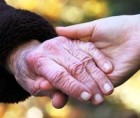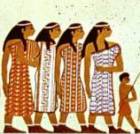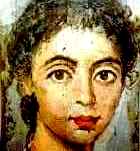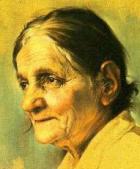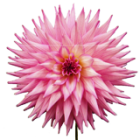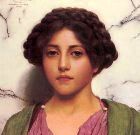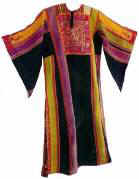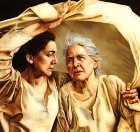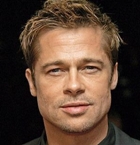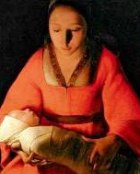Questions for Bible study groups
- Who were Ruth and Naomi in the Bible?
- Why is the story of Ruth and Naomi so famous?
- Are there any lessons in their story for someone in the modern world?
- Which painting do you like best? Why?
Paintings of Ruth’s story
Who were Ruth & Naomi?
- Ruth was a Moabite, a foreigner from a hated country. But she married a Hebrew man, and after his death she left her native land and went with her mother-in-law Naomi to
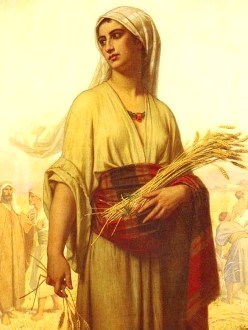 Bethlehem in Israel. Here she was allowed to glean left-over corn in the fields belonging to Boaz, a rich bachelor and kinsman of Naomi.
Bethlehem in Israel. Here she was allowed to glean left-over corn in the fields belonging to Boaz, a rich bachelor and kinsman of Naomi. - Ruth’s behaviour was exemplary. She was modest among the young men harvesting the grain, and took only what she was entitled to.
- She knew Boaz was attracted to her, but he did nothing. She waited. Nothing. So one night she went and lay at his feet as he slept in the field – though for a fuller explanation of what ‘at his feet’ may have meant, read here.
- Boaz saw her beauty, intelligence and virtue, and proposed. They married and lived happily ever after.
- Ruth was the great-grandmother of David and therefore an ancestress of Christ – hence her place in Christian art.
‘Whither thou goest’,
Sandy Freckleton Gagan
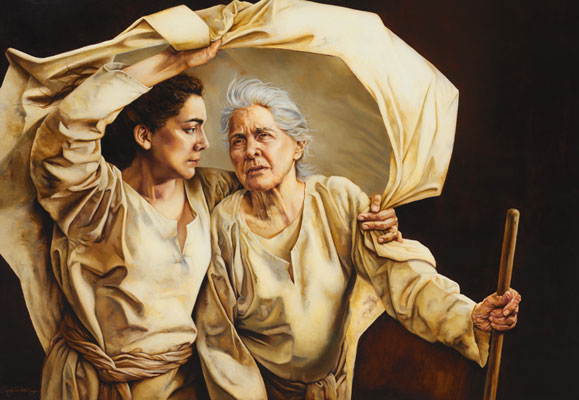
This extraordinary modern painting of Ruth and Naomi captures the essence of the story: the mutual dependence of people within a family. It shows
- the younger woman, Naomi, sheltering and protecting the elderly woman (billowing cape as shield against harsh weather, supportive arm around the shoulder) and
- the older woman leading the way (staff in her hand, grey hair signalling wisdom and experience)
Together, the figures form a single unit, stronger together than they would be if they had gone their separate ways.
‘Ruth’s Story’, Thomas Matthews Rooke, 1876
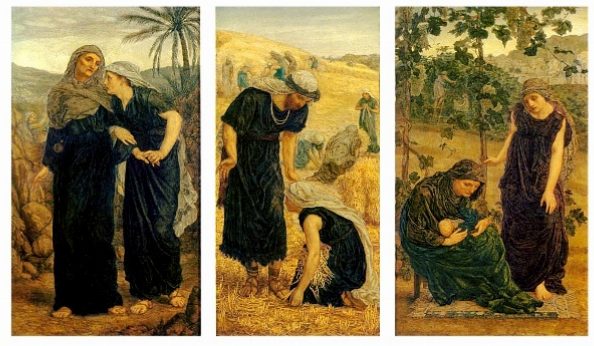
The triptych shows the three central moments of the story: Ruth’s adherance to Naomi; her meeting with Boaz; and the little son who would become the grandfather of King David.
Rooke was never as famous as Burne-Jones, whose assistant he was – and this triptych shows what a pity that was. The images are lovely, glowing with the golden light of summer and yet able to convey the cloud that hung over the lives of Ruth and Naomi in their dangerous predicament. Each of the figures is graceful, rounded, flowing, and there is a sense of stillness and peace over all.
Bible reference: Book of Ruth 1:1-18
‘Ruth and Naomi’, Philip Calderon, 1920
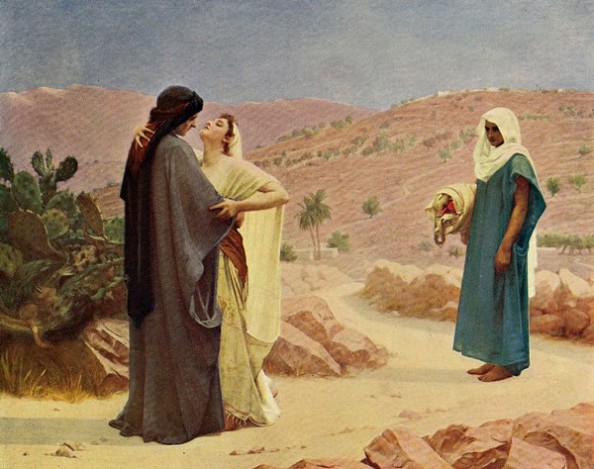
The moment for parting has come. Naomi tells her two daughters-in-law to go back to their families, while she returns to Bethlehem. Orpah is ready to go, but what is Ruth doing? Her body language is confused, to say the least, holding on to Naomi with her right hand but seeming to push her away with her left.
Calderon’s paintings were never straightforward, and several of them were sexually ambivalent – ‘St Elizabeth of Hungary’s Great Act of Renunciation’ for example, or even perhaps ‘Whither’. Hmmm…
Bible reference: Book of Ruth 1:1-18
Ruth, Naomi and Orpah, Chagall
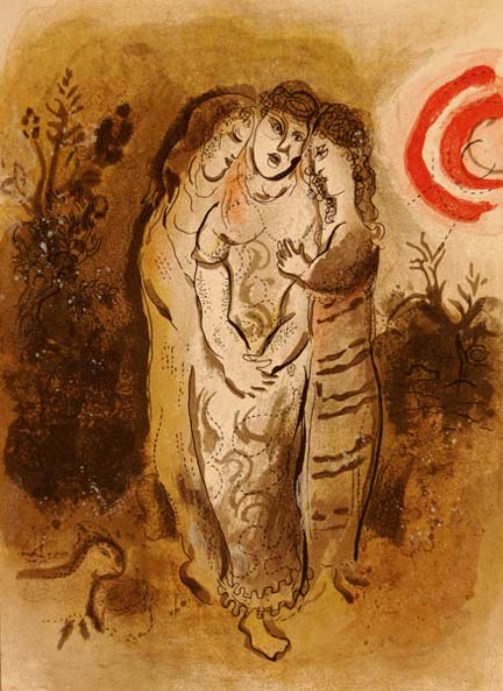
The women are bereft, and cling so closely together that it seems they are trying to share their body. Each of them is beautiful, each an individual. Naomi is at the center, forming the core of the group. Her foot forms the bottom of the V-shaped whole. What is the small animal beside them? A lamb?
This is the first in the series Chagall produced on the story of Ruth and Naomi. The recurring colors are brown and glowing red – here brown predominates, making the mood of the picture more somber. The women huddle together, comforting each other in their grief.
But behind them, portent of something in the future, a red sun throbs with life…
Bible reference: Book of Ruth 1:1-18
‘Ruth and Naomi’, William Blake, 1795
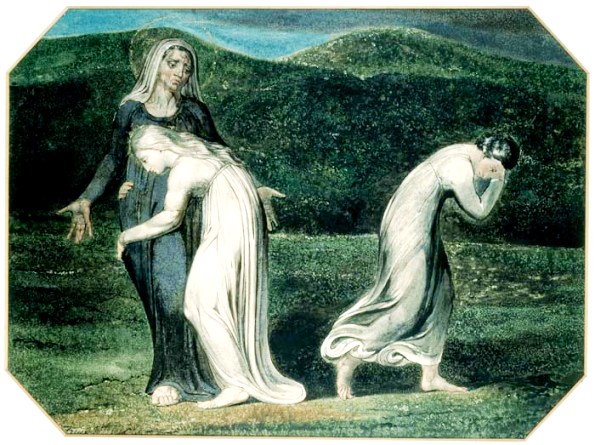
It is the moment of parting. Orpah moves away, but Ruth clings desperately onto Naomi, whose widespread hands seem to say ‘But I can offer you nothing’.
This has all the characteristics of a William Blake – the flowing lines, muted colors and mournful humans he specialized in. The drapery on the women is very beautiful, the lines echoed in the rolling landscape behind. Blake has captured the desolation of their grief, and their seemingly hopeless predicament as well.
Bible reference: Book of Ruth 1:1-18
Ruth and Naomi, Pieter Lastman, 1624
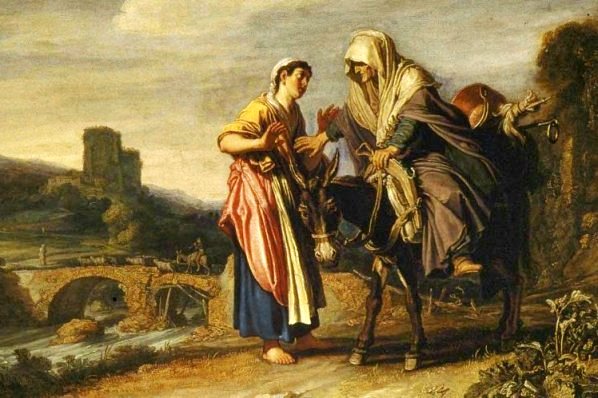
Naomi pushes the younger woman away from her. She is on the point of setting out on her journey home. She wants the young woman to do the same. The bridge behind the two women is the road leading west, back to Bethlehem where Naomi comes from.
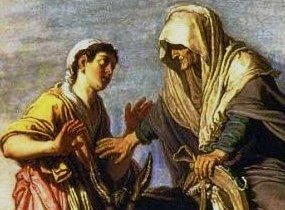 But Ruth looks at her in silent reproach. In a moment, she will make her famous speech of loyalty.
But Ruth looks at her in silent reproach. In a moment, she will make her famous speech of loyalty.
Notice especially the interplay of expressive hand motions of both women. They are hard-working peasants’ hands, but eloquent neverthless.
Bible reference: Book of Ruth 1:1-18
Ruth and Naomi’, Ary Scheffer, circa 1870
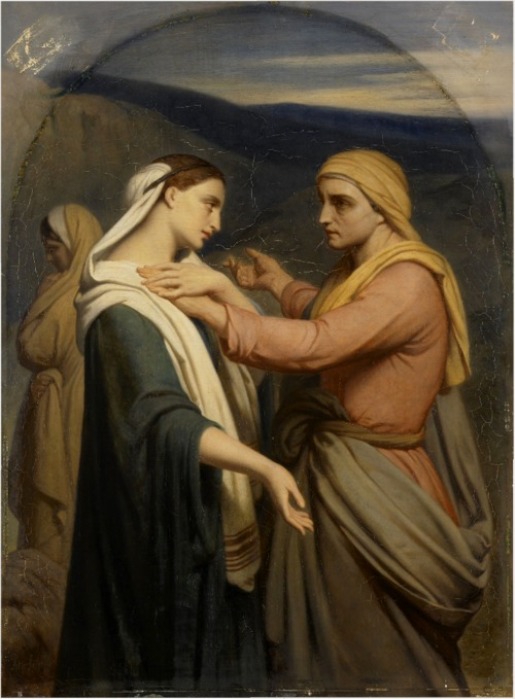
Naomi points away to the west, directing Ruth back to her original family, but Ruth covers Naomi’s other hand, signaling that she will hold onto the older woman, come what may.
Scheffer’s paintings are currently out of favor because they are seen as too ‘sentimental’ and old-fashioned – and in fact they do remind the viewer of Victorian-era holy cards.
But look more closely. The colors are muted and harmonious, admirably expressing the grief these two widows feel. The composition is flowing so that the two figures are joined, linked together by ties of loyalty and love. The colors in the background are somber, but both women sear headscarves in brighter colors – the future, Scheffer suggests, will be kinder to them than the past.
Bible reference: Book of Ruth 1:1-18
‘Ruth Gleaning’, Marc Chagall, 1960
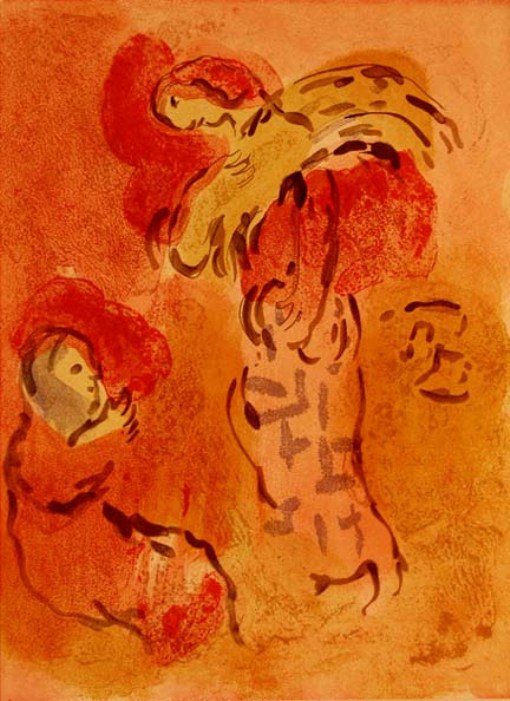
It is late summer, and the harvest is being brought in. This is when Ruth goes to glean in the fields of Boaz, a rich landowner.
Chagall captures the burning heat of a day out in the open fields at harvest time. The whole pictures throbs with the sun – clearly there is no way of escaping it. But Ruth’s strong upright figure keeps working, even when others stop to rest, because she must try to gather as much food as she can, to feed the two destitute women during the coming winter.
The plight of penniless widows in ancient Israel was precarious, to say the least.
Bible reference: Book of Ruth 2
‘Ruth Gleaning’, James Tissot, 1896
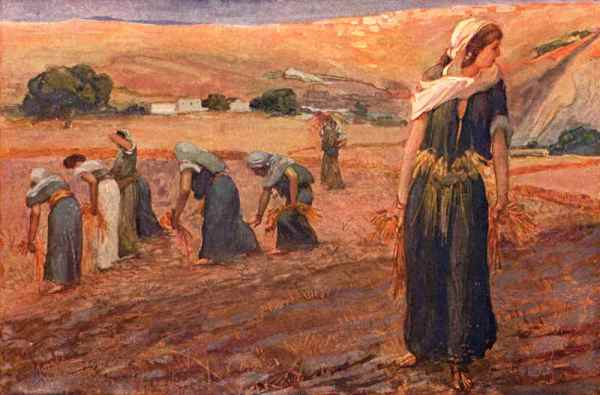
Ruth has been working steadily, gleaning the strands of grain left over and dropped. But something has caught her attention and distracted her from her work. The viewer presumes it is Boaz, who has arrived at the field he owns.
This is one of the watercolors produced by Tissot late in his career, when he journeyed to Palestine to make a series of paintings on biblical subjects. The watercolors he produced there are quite different to his earlier, formal paintings. Beautiful as they, they do not have the spontaneity of this painting of Ruth.
Bible reference: Book of Ruth 2
‘Ruth in the Fields’, Merle Hugues, 1876
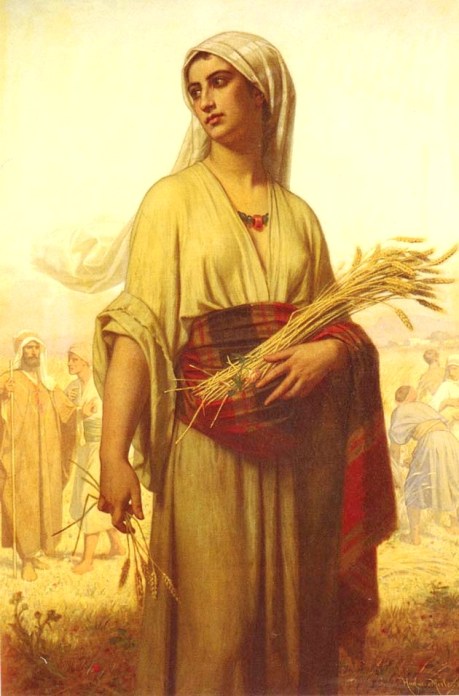
Boaz turns towards Ruth, looking at her as he gives instructions to the servant standing beside him. She turns her head towards the two men – can she hear what is being said?
Many of Merle Hugues’ paintings focused on familial love and loyalty, so it was inevitable that the story of Ruth and Naomi would interest him. His Ruth is a beautiful young woman, dressed simply except for the lovely necklace she wears round her throat. Her figure is voluptuous but her head is modestly covered – there are many messages being sent by this painting.
The sheaves of wheat she holds are not only of the present, but of the future – she will be fertile, and Hugues’ Ruth could almost double as the Roman goddess Ceres.
Bible reference: Book of Ruth 2
‘Boaz and Ruth’, William Morris, circa 1865
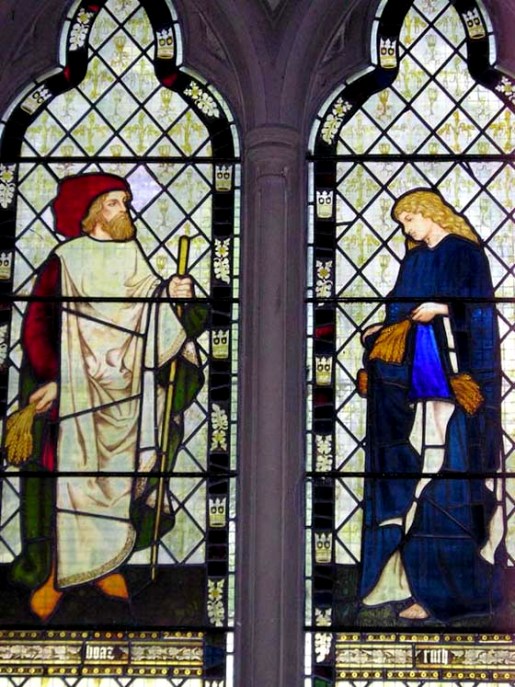
Boaz and Ruth both hold sheaves of wheat, a hint of their own future fertility. Ruth holds so much wheat that she must gather it up in a fold of her cloak. Boaz is richly but simply clothed; Ruth has more modest clothing and is barefoot, a sign of her poverty.
This is a window in the north aisle of the Sacred Heart Church, North Gosforth. Many of the windows in this church were designed by Edward Burne-Jones, but this one was by William Morris, and was produced by the William Morris Company. It was dedicated to Edward Knollys.
One of the interesting things about these windows is that the background details are muted – most stained glass windows have landscapes of buildings in the background. The result of this relative simplicity is that the figures are thrown into greater prominence, making you really look at them.
Bible reference: Book of Ruth 2
‘Ruth Meets Boaz’, Edward Burne-Jones, 1879
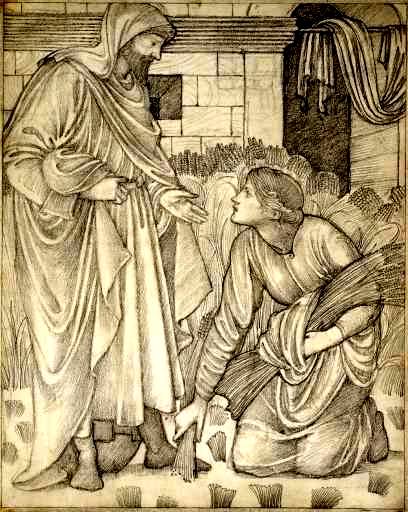
Ruth stops her task for a moment and looks up, responding to the outstretched hand of Baoz. His gesture says it all – he will help her, if she will accept him.
The delicacy and skill of this drawing is breathtaking. Boaz’ figure dominates the left side of the picture, but our eyes are drawn to the figure of Ruth, gracefully bending to pick up a bundle of grain.
Burne-Jones was originally a Theology student at Oxford, but his contact with Rossetti changed his life. The two men met at Oxford, where Rossetti was working on his decorations for the Oxford Union. Burne-Jones had no training, but his drawings caught Rossetti’s attention, and the young student was allowed to contribute ‘The Death of Merlin’ to the Union Debating Room.
After this, Burne-Jones abandoned his studies in theology for a career as an artist. He served God better, perhaps, through his art.
Bible reference: Book of Ruth 2
‘Ruth and Boaz meet’, Marc Chagall, 1960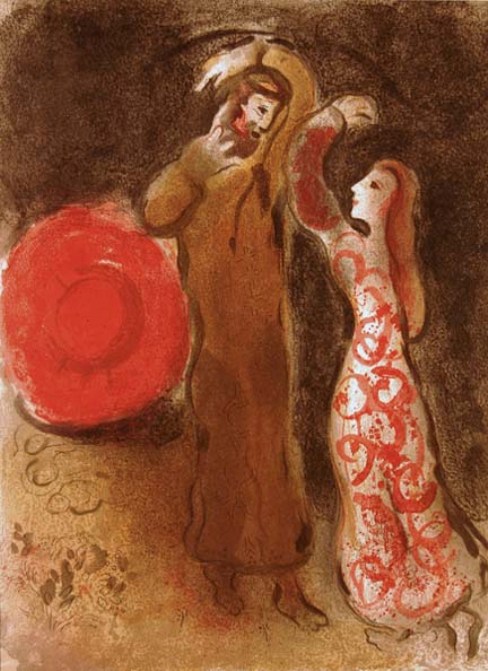
Ruth and Boaz meet face to face for the first time, and it is clearly a joyful moment for both of them.
Look at the expression on Boaz’ face. There is joy, but there is something else as well – something like recognition. Is Chagall suggesting that love at first sight – which Boaz is certainly experiencing – is like a sudden awareness that the person in front of us is meant to be The One? His happy amazement shows not only on his face, but in his upflung arms.
Ruth’s face is more serene, but just as happy, and she echoes his body language with her own upflung arm.
But tell me, what on earth does the red orb behind Boaz signify?
Bible reference: Book of Ruth 2
‘Ruth Meets Boaz’, Nicolas Poussin, 1660
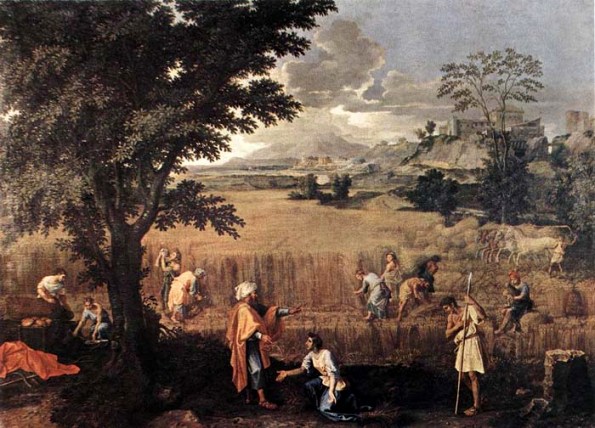
The servant at the right of the picture bows to show that he has heard Boaz’ command, and will obey it. Ruth kneels before Boaz, thanking him for his generosity and for his adherence to chesed, the sense of loyalty and benevolence towards those in need.
Poussin was at the height of his powers when he painted ‘Ruth meets Boaz’. The Arcadian landscape is orderly, an earthly paradise, and the people within this landscape are calm, hardworking, and completely in harmony with their environment.
This is Nature and humanity as it should be, Poussin seems to say
Bible reference: Book of Book of Ruth 2
‘Boaz pouring six measures of barley into Ruth’s veil’, Rembrandt, 1650
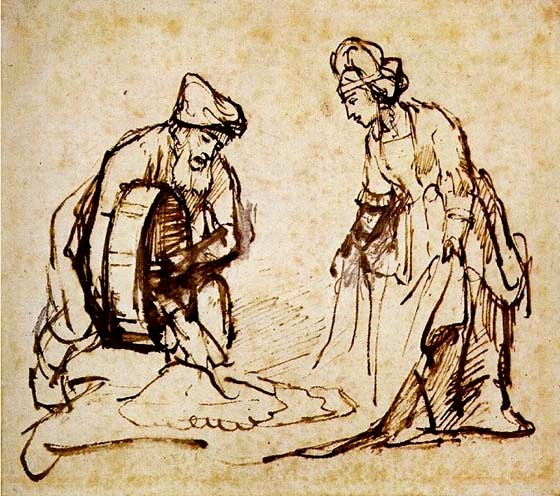
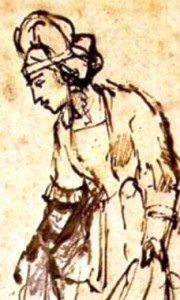
Boaz not only instructs his workers to leave grain for Ruth to pick up, but gives her a considerable amount, in fact. By the end of the first day Ruth has gleaned about two-thirds of a bushel, quite a lot for one day’s gleaning.
Rembrandt captures Boaz’ eager generosity, his will to please, in this lovely drawing. He is not a young man, but he is more than willing to lavish whatever he can on this young woman.
She leans gracefully towards him, a slightly bemused look on her face.
Bible reference: Book of Ruth 2
‘Ruth in Boaz’ Field’,
Julius Schnorr von Carolsfeld, 1828
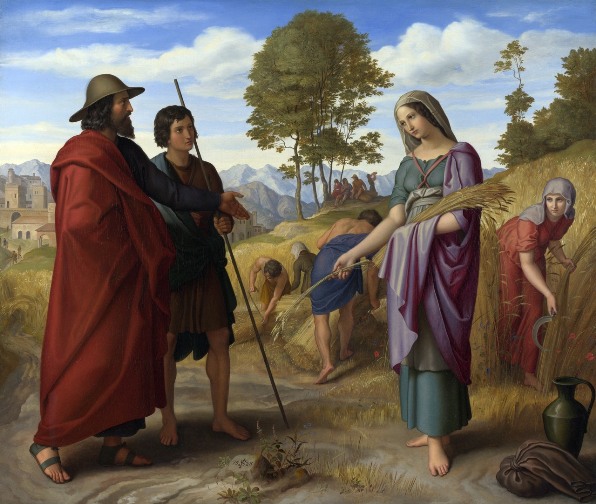
Boaz is speaking to Ruth, reassuring her and giving her permission to glean in his fields. Ruth listens quietly, her demeanor modest and grateful. The ideal Early Victorian Woman.
Carolsfeld was a deeply religious man, and some of his best work is on biblical subjects. There is little to startle the viewer in this painting, nothing that will frighten the horses, but it has a calm order and harmony that reflected the early Victorian interpretation of the story of Ruth and Boaz.
Bible reference: Book of Ruth 2
‘Landscape with Ruth and Boaz’,
Josep Anton Koch, 1768
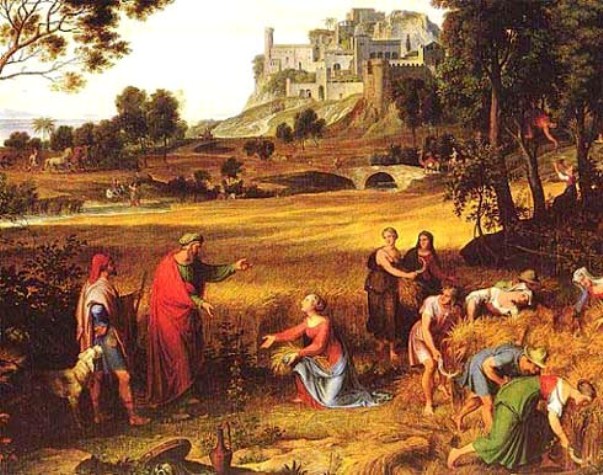
Boaz approaches Ruth and tells her that she is welcome to glean in his fields, and that she may do so in safety. She in turn extends her hand in a grateful gesture of thanks.
Koch was primarily a landscape painter, and clearly the scene behind the figures is saying something about the story. In this case, the fertile fields and civilized background echo the nobility of Boaz, and the serenity of Ruth. The workers in the field are busy and all, Koch seems to say, is as it should be.
Bible reference: Book of Ruth 2
‘Ruth and Boaz’,
Barent Pietersz Fabritius, 1660
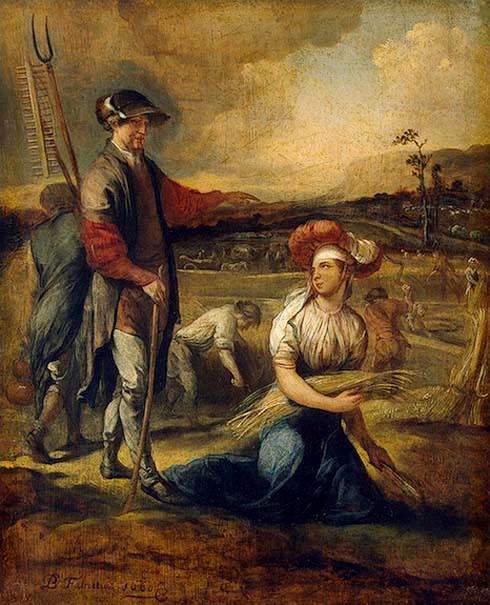
Boaz, his hand stretched out towards her, directs Ruth to take grain from his field. She in turn looks gratefully up towards him,
In this painting Boaz appears not as an ancient Jewish landowner, but as a member of the 17th century landed gentry, tight-fitting breeches and all. His manner towards the young girl gleaning on his land is benevolent.
Ruth seems to be wearing an extraordinary padded hat to shield her pale skin from the sun. There is not the slightest attempt to portray the story in its historical setting; the story has been transplanted to the Protestant Netherlands – quite right too, since it is a timeless and universal story.
Bible reference: Book of Ruth 2
‘Ruth at the feet of Boaz’, Marc Chagall, 1960
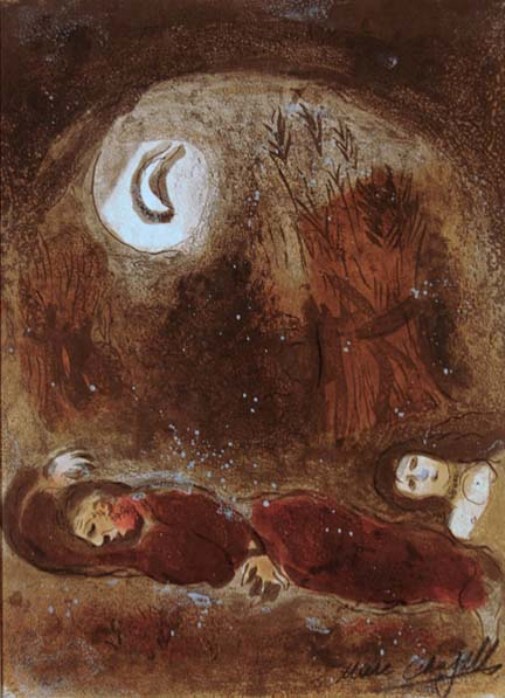
It is night, a dim landscape, with only the moon bathing the land in its light. Boaz is clearly asleep, cradling his head on his arm, but Ruth is not. Her eyes are open, her breasts visible and the expression on her face shows that she, God bless her, is up to mischief.
It is easy enough to paint a scene in broad daylight, but here the landscape is shrouded in darkness.
Even so, Chagal has brought the moment vividly to life. The shimmering light of the moon dominates – the Moon after all is the Woman Planet in ancient lore, and its circle is duplicated by Ruth’s round breasts. Her face is bright with expectation – this is a pivotal moment in her life.
Bible reference: Book of Ruth 2
‘Boaz wakes and sees Ruth at his feet’, Marc Chagall, 1960
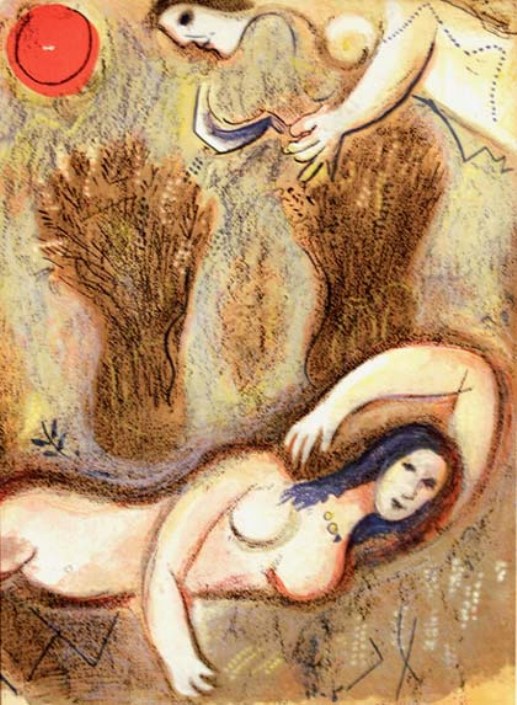
When Boaz wakes in the morning on the threshing floor, he sees Ruth lying beside him. Following Naomi’s advice, she has nudged Boaz into a position where he must propose to her.
A red sun throbs in the top right hand corner in this paean to love and sexual joy. Ruth and Boaz wake in the morning, together on the threshing floor during harvest time. They are surrounded by sheaves of grain, signs of prosperity and a plentiful future.
Both of them seem to be naked – Chagall has no doubts about what has occurred the night before, even if the Bible demurs on this point. Ruth is a happy woman, and Boaz positively soars.
Bible reference: Book of Ruth 3
‘Ruth and Obed (left) with Salmon’ (right),
Michelangelo, 1508-1512, Sistine chapel
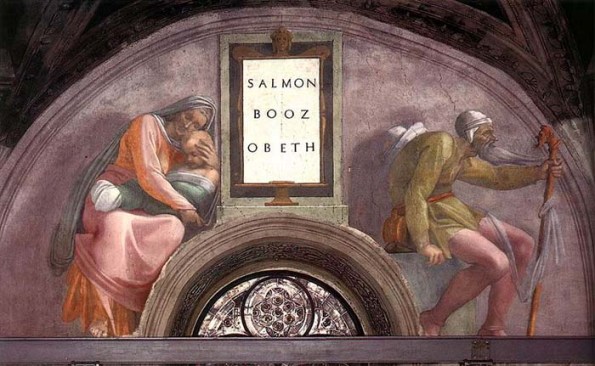
On the left side of the painting Ruth cradles her son Obed. Her breast sags at the opening of her bodice, and the baby, now full of warm milk, dozes quietly.
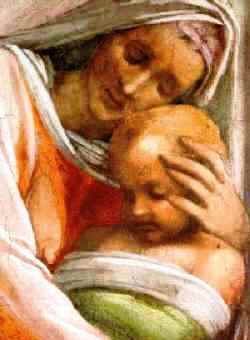 On the right side (despite what Wikipedia says!!) is Salmon, father of Boaz or Booz as Michelangelo calls him. Salmon has the staff, hat and garb of a traveller, reminding the viewer that he accompanied Moses on part of the trek from Egypt, and was commissioned by Moses to be Prince of the Tribe of Judah, from which Jesus would come.
On the right side (despite what Wikipedia says!!) is Salmon, father of Boaz or Booz as Michelangelo calls him. Salmon has the staff, hat and garb of a traveller, reminding the viewer that he accompanied Moses on part of the trek from Egypt, and was commissioned by Moses to be Prince of the Tribe of Judah, from which Jesus would come.
The caption on Michelangelo’s painting makes it clear that this image is about genealogy. There is a straight line between Salmon, who knew Moses (though only when Moses was very old and Salmon was very young) and was present at the birth of the Israelite nation — right through to Obed, who would be the grandfather of King David.
‘Ruth and Naomi’, He Qi, 2001
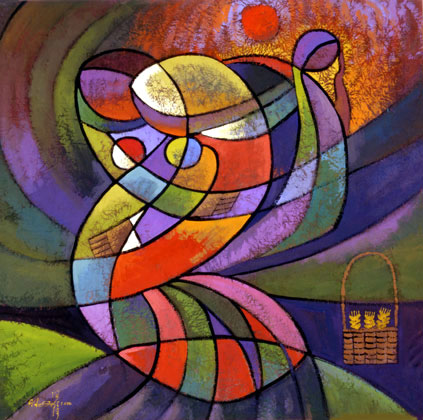
This exuberant painting is a capsule of the story, its culmination, and its happy ending.
What a joyful swirl of humanity! The figures twine together so harmoniously you can hardly tell where either one of them begins and ends, even though each has its own distinctive colors.
As it should be with a family. Harmony in Nature, with a glowing sun behind and green swaths beneath their feet.
Bible reference: Book of Ruth
Ruth, Naomi, Boaz: Love was in the Air
There was a famine, and the family of a woman called Naomi went to Moab to look for food. While they were there, all the men in the family died, and the women had to fend for themselves. Naomi, being the matriarch of the group, told the young women, including Ruth, to head for home. She would do the same, parting company with them.
One of them refused to leave her – a young Moabite (and therefore an outsider) called Ruth. She stuck like glue. ‘Where you go, I will go. Where you lodge, I will lodge. Your people shall be my people and your God my God. Where you die, I will die and there I will be buried.’
So the two women set out for Bethlehem, Naomi’s home. When they got there, they had very little else besides their wits. Ruth decided she would help glean the barley in the fields, to feed herself and Naomi and to get a store of grain for winter.
Ruth went to the field of Boaz, a rich relative of Naomi’s. Boaz was an ideal match for any young woman – single, well respected and rich. When he saw Ruth, it was love at first sight.
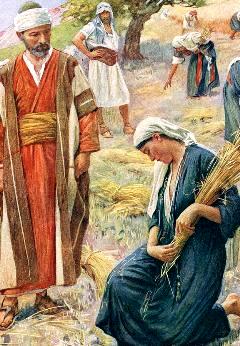 He made a bit of an idiot of himself, trying to help her, getting extra grain for her, protecting her, seeing she was well fed. It was clear to everyone that love was in the air, but how to nudge him into proposing?
He made a bit of an idiot of himself, trying to help her, getting extra grain for her, protecting her, seeing she was well fed. It was clear to everyone that love was in the air, but how to nudge him into proposing?
The older woman stepped forward, telling Ruth exactly what to do. Ruth had the good sense to listen. She perfumed herself, dressed in her most becoming clothes, and waited at the threshing floor until Boaz had eaten a good meal – a man with a full stomach was always more amenable.
When Boaz finally lay down to sleep, Ruth approached him and lay ‘at his feet’ – ‘feet’ was often a euphemism for male genitals. When he awoke and saw her, she suggested he ‘cover her with his blanket’ – again a euphemism, but this time for marriage. Boaz was only too happy to oblige.
Soon after, they were married, and Ruth had a son, Obed, who was the father of Jesse, who was the father of King David.
So Ruth, once the destitute outsider, became the great-grand-mother of a king. Naomi, who had lost her husband and two sons, now held her little grandson close, becoming his nurse.
And they lived happily ever after.
The Book of Ruth – the Bible text
Misfortune for Ruth’s Family
1 In the days when the judges ruled, there was a famine in the land, and a certain man of Bethlehem in Judah went to live in the country of Moab, he and his wife and two sons.
2 The name of the man was Elimelech and the name of his wife Naomi, and the names of his two sons were Mahlon and Chilion; they were Ephrathites from Bethlehem in Judah. They went into the country of Moab and remained there.
3 But Elimelech, the husband of Naomi, died, and she was left with her two sons.
4 These took Moabite wives; the name of one was Orpah and the name of the other Ruth. When they had lived there for about ten years,
5 both Mahlon and Chilion also died, so that the woman was left without her two sons or her husband.
The Family Splits Up
6 Then she started to return with her daughters-in-law from the country of Moab, for she had heard in the country of Moab that the Lord had had consideration for his people and given them food.
7 So she set out from the place where she had been living, she and her two daughters-in-law, and they went on their way to go back to the land of Judah.
8 But Naomi said to her two daughters-in-law, ‘Go back each of you to your mother’s house. May the Lord deal kindly with you, as you have dealt with the dead and with me.
9 The Lord grant that you may find security, each of you in the house of your husband.’ Then she kissed them, and they wept aloud.
10 They said to her, ‘No, we will return with you to your people.’
11 But Naomi said, ‘Turn back, my daughters, why will you go with me? Do I still have sons in my womb that they may become your husbands?
12 Turn back, my daughters, go your way, for I am too old to have a husband. Even if I thought there was hope for me, even if I should have a husband tonight and bear sons,
13 would you then wait until they were grown? Would you then refrain from marrying? No, my daughters, it has been far more bitter for me than for you, because the hand of the Lord has turned against me.’
14 Then they wept aloud again. Orpah kissed her mother-in-law, but Ruth clung to her.
Ruth’s Loyalty to Naomi
15 So she said, ‘See, your sister-in-law has gone back to her people and to her gods; return after your sister-in-law.’
16But Ruth said, ‘Do not press me to leave you or to turn back from following you!
Where you go, I will go; where you lodge, I will lodge; your people shall be my people, and your God my God.
17Where you die, I will die—there will I be buried.
May the Lord do thus and so to me, and more as well, if even death parts me from you!’
18When Naomi saw that she was determined to go with her, she said no more to her.
19 So the two of them went on until they came to Bethlehem. When they came to Bethlehem, the whole town was stirred because of them; and the women said, ‘Is this Naomi?’
20She said to them,‘Call me no longer Naomi, call me Mara, for the Almighty has dealt bitterly with me.
21I went away full, but the Lord has brought me back empty; why call me Naomi when the Lord has dealt harshly with me, and the Almighty has brought calamity upon me?’
22 So Naomi returned together with Ruth the Moabite, her daughter-in-law, who came back with her from the country of Moab. They came to Bethlehem at the beginning of the barley harvest.
Ruth Meets Boaz, a Rich Relative
1 Now Naomi had a kinsman on her husband’s side, a prominent rich man, of the family of Elimelech, whose name was Boaz.
2 And Ruth the Moabite said to Naomi, ‘Let me go to the field and glean among the ears of grain, behind someone in whose sight I may find favour.’ She said to her, ‘Go, my daughter.’
3 So she went. She came and gleaned in the field behind the reapers. As it happened, she came to the part of the field belonging to Boaz, who was of the family of Elimelech.
4 Just then Boaz came from Bethlehem. He said to the reapers, ‘The Lord be with you.’ They answered, ‘The Lord bless you.’
5 Then Boaz said to his servant who was in charge of the reapers, ‘To whom does this young woman belong?’
6 The servant who was in charge of the reapers answered, ‘She is the Moabite who came back with Naomi from the country of Moab.
7 She said, “Please let me glean and gather among the sheaves behind the reapers.” So she came, and she has been on her feet from early this morning until now, without resting even for a moment.’
Ruth Gleans the Grain
8 Then Boaz said to Ruth, ‘Now listen, my daughter, do not go to glean in another field or leave this one, but keep close to my young women.
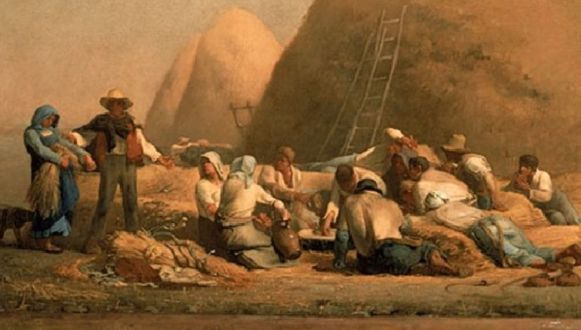
9 Keep your eyes on the field that is being reaped, and follow behind them. I have ordered the young men not to bother you. If you get thirsty, go to the vessels and drink from what the young men have drawn.’
10 Then she fell prostrate, with her face to the ground, and said to him, ‘Why have I found favour in your sight, that you should take notice of me, when I am a foreigner?’
11 But Boaz answered her, ‘All that you have done for your mother-in-law since the death of your husband has been fully told me, and how you left your father and mother and your native land and came to a people that you did not know before.
12 May the Lord reward you for your deeds, and may you have a full reward from the Lord, the God of Israel, under whose wings you have come for refuge!’
13 Then she said, ‘May I continue to find favour in your sight, my lord, for you have comforted me and spoken kindly to your servant, even though I am not one of your servants.’
14 At mealtime Boaz said to her, ‘Come here, and eat some of this bread, and dip your morsel in the sour wine.’ So she sat beside the reapers, and he heaped up for her some parched grain. She ate until she was satisfied, and she had some left over.
15 When she got up to glean, Boaz instructed his young men, ‘Let her glean even among the standing sheaves, and do not reproach her.
16 You must also pull out some handfuls for her from the bundles, and leave them for her to glean, and do not rebuke her.’
22 Naomi said to Ruth, her daughter-in-law, ‘It is better, my daughter, that you go out with his young women, otherwise you might be bothered in another field.’
23 So she stayed close to the young women of Boaz, gleaning until the end of the barley and wheat harvests; and she lived with her mother-in-law.
Naomi Advises Ruth
1 Naomi her mother-in-law said to her, ‘My daughter, I need to seek some security for you, so that it may be well with you.
2 Now here is our kinsman Boaz, with whose young women you have been working. See, he is winnowing barley tonight at the threshing-floor.
3 Now wash and anoint yourself, and put on your best clothes and go down to the threshing-floor; but do not make yourself known to the man until he has finished eating and drinking.
4 When he lies down, observe the place where he lies; then, go and uncover his feet and lie down; and he will tell you what to do.’
5 She said to her, ‘All that you tell me I will do.’
Ruth Takes the Advice
6 So she went down to the threshing-floor and did just as her mother-in-law had instructed her.
7 When Boaz had eaten and drunk, and he was in a contented mood, he went to lie down at the end of the heap of grain. Then she came quietly and uncovered his feet, and lay down.
8 At midnight the man was startled and turned over, and there, lying at his feet, was a woman!
9 He said, ‘Who are you?’ And she answered, ‘I am Ruth, your servant; spread your cloak over your servant, for you are next-of-kin.’
10 He said, ‘May you be blessed by the Lord, my daughter; this last instance of your loyalty is better than the first; you have not gone after young men, whether poor or rich.
11 And now, my daughter, do not be afraid; I will do for you all that you ask, for all the assembly of my people know that you are a worthy woman.
12 But now, though it is true that I am a near kinsman, there is another kinsman more closely related than I.
13 Remain this night, and in the morning, if he will act as next-of-kin for you, good; let him do so. If he is not willing to act as next-of-kin for you, then, as the Lord lives, I will act as next-of-kin for you. Lie down until the morning.’
14 So she lay at his feet until morning, but got up before one person could recognize another; for he said, ‘It must not be known that the woman came to the threshing-floor.’
15 Then he said, ‘Bring the cloak you are wearing and hold it out.’ So she held it, and he measured out six measures of barley, and put it on her back; then he went into the city.
16She came to her mother-in-law, who said, ‘How did things go with you, my daughter?’ Then she told her all that the man had done for her,
17 saying, ‘He gave me these six measures of barley, for he said, “Do not go back to your mother-in-law empty-handed.” ’
18 She replied, ‘Wait, my daughter, until you learn how the matter turns out, for the man will not rest, but will settle the matter today.’
Ruth and Boaz Marry
1 No sooner had Boaz gone up to the gate and sat down there than the next-of-kin, of whom Boaz had spoken, came passing by. So Boaz said, ‘Come over, friend; sit down here.’ And he went over and sat down.
2 Then Boaz took ten men of the elders of the city, and said, ‘Sit down here’; so they sat down.
3 He then said to the next-of-kin, ‘Naomi, who has come back from the country of Moab, is selling the parcel of land that belonged to our kinsman Elimelech.
4 So I thought I would tell you of it, and say: Buy it in the presence of those sitting here, and in the presence of the elders of my people. If you will redeem it, redeem it; but if you will not, tell me, so that I may know; for there is no one prior to you to redeem it, and I come after you.’ So he said, ‘I will redeem it.’
5 Then Boaz said, ‘The day you acquire the field from the hand of Naomi, you are also acquiring Ruth the Moabite, the widow of the dead man, to maintain the dead man’s name on his inheritance.’
6 At this, the next-of-kin said, ‘I cannot redeem it for myself without damaging my own inheritance. Take my right of redemption yourself, for I cannot redeem it.’
7 Now this was the custom in former times in Israel concerning redeeming and exchanging: to confirm a transaction, one party took off a sandal and gave it to the other; this was the manner of attesting in Israel.
8So when the next-of-kin said to Boaz, ‘Acquire it for yourself’, he took off his sandal.
9Then Boaz said to the elders and all the people, ‘Today you are witnesses that I have acquired from the hand of Naomi all that belonged to Elimelech and all that belonged to Chilion and Mahlon.
10I have also acquired Ruth the Moabite, the wife of Mahlon, to be my wife, to maintain the dead man’s name on his inheritance, in order that the name of the dead may not be cut off from his kindred and from the gate of his native place; today you are witnesses.’
11Then all the people who were at the gate, along with the elders, said, ‘We are witnesses. May the Lord make the woman who is coming into your house like Rachel and Leah, who together built up the house of Israel. May you produce children in Ephrathah and bestow a name in Bethlehem;
12 and, through the children that the Lord will give you by this young woman, may your house be like the house of Perez, whom Tamar bore to Judah.’
Ruth Has a Son, Ancestor of David and Jesus
13 So Boaz took Ruth and she became his wife. When they came together, the Lord made her conceive, and she bore a son.
14 Then the women said to Naomi, ‘Blessed be the Lord, who has not left you this day without next-of-kin; and may his name be renowned in Israel!
Save
Bible Art: Paintings and Artworks from the Old and New Testament
Bible Study Resource
Ruth, Naomi and Boaz:
one of the great love stories of the Old Testament
Ruth & Naomi links
At Last,
a Happy Ending!
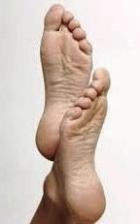
When Boaz lay down to sleep, Ruth approached him and lay ‘at his feet’ – ‘feet’ being a euphemism for male genitals. When he awoke and saw her, she suggested he ‘cover her with his blanket’ – again a euphemism, but this time for marriage.
Read more…
__________
The Book of Ruth
‘Now wash and anoint yourself, Naomi said, and put on your best clothes and go down to the threshing floor. When he lies down, observe the place where he lies; then, go and uncover his feet and lie down.’
Read more…
__________
Ruth & Naomi –
their story
‘…although Naomi was destitute, she had good family connections. Furthermore, both she and Ruth were women of initiative. They did not believe in sitting down and letting events simply happen.
__________
Choosing a Husband
‘One of the qualities that a Jewish woman looked for in a husband was that he was physically attractive, because Jews believed a happy sex life was one of the greatest gifts God gave to a married couple.’
__________
Young People in the Bible
Ruth had the good sense to listen to Naomi’s advice, and the love story has a happy ending – the triumph of courage and loyalty over adverse circumstances.’
__________
Giving birth in ancient times
‘When a woman like Ruth went into labor, she was the center of a tight little band of kinswomen and villagers: a midwife, her relatives and her friends. She knew what to expect, having seen other village women giving birth…’
__________
© Copyright 2006
Elizabeth Fletcher

